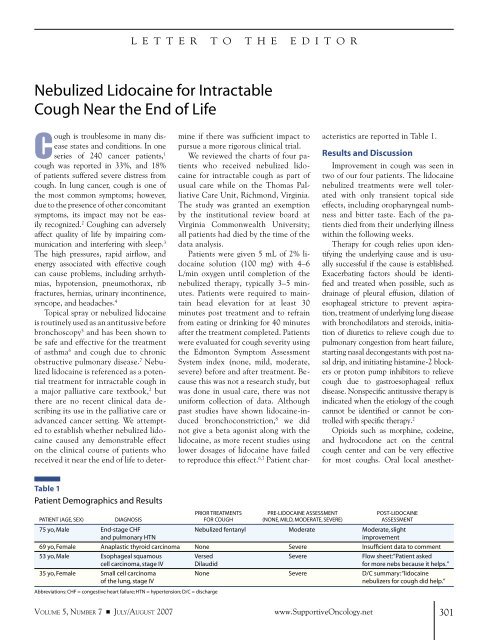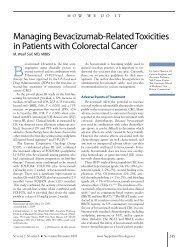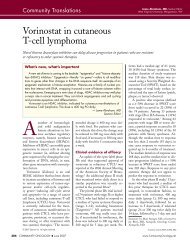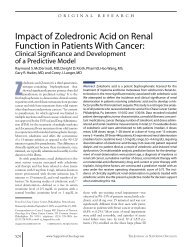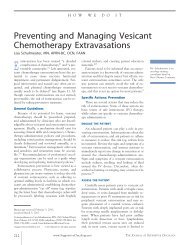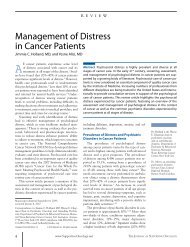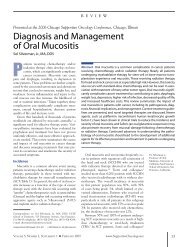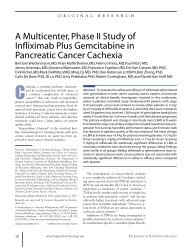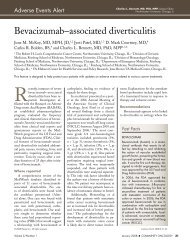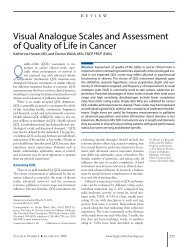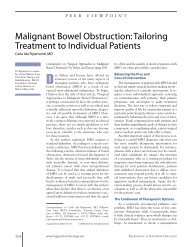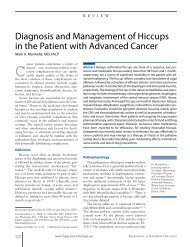Nebulized Lidocaine for Intractable Cough Near the End of Life
Nebulized Lidocaine for Intractable Cough Near the End of Life
Nebulized Lidocaine for Intractable Cough Near the End of Life
Create successful ePaper yourself
Turn your PDF publications into a flip-book with our unique Google optimized e-Paper software.
L E T T E R T O T H E E D I T O R<br />
<strong>Nebulized</strong> <strong>Lidocaine</strong> <strong>for</strong> <strong>Intractable</strong><br />
<strong>Cough</strong> <strong>Near</strong> <strong>the</strong> <strong>End</strong> <strong>of</strong> <strong>Life</strong><br />
C<br />
ough is troublesome in many disease<br />
states and conditions. In one<br />
series <strong>of</strong> 240 cancer patients, 1<br />
cough was reported in 33%, and 18%<br />
<strong>of</strong> patients suffered severe distress from<br />
cough. In lung cancer, cough is one <strong>of</strong><br />
<strong>the</strong> most common symptoms; however,<br />
due to <strong>the</strong> presence <strong>of</strong> o<strong>the</strong>r concomitant<br />
symptoms, its impact may not be easily<br />
recognized. 2 <strong>Cough</strong>ing can adversely<br />
affect quality <strong>of</strong> life by impairing communication<br />
and interfering with sleep. 3<br />
The high pressures, rapid airflow, and<br />
energy associated with effective cough<br />
can cause problems, including arrhythmias,<br />
hypotension, pneumothorax, rib<br />
fractures, hernias, urinary incontinence,<br />
syncope, and headaches. 4<br />
Topical spray or nebulized lidocaine<br />
is routinely used as an antitussive be<strong>for</strong>e<br />
bronchoscopy 5 and has been shown to<br />
be safe and effective <strong>for</strong> <strong>the</strong> treatment<br />
<strong>of</strong> asthma 6 and cough due to chronic<br />
obstructive pulmonary disease. 7 <strong>Nebulized</strong><br />
lidocaine is referenced as a potential<br />
treatment <strong>for</strong> intractable cough in<br />
a major palliative care textbook, 2 but<br />
<strong>the</strong>re are no recent clinical data describing<br />
its use in <strong>the</strong> palliative care or<br />
advanced cancer setting. We attempted<br />
to establish whe<strong>the</strong>r nebulized lidocaine<br />
caused any demonstrable effect<br />
on <strong>the</strong> clinical course <strong>of</strong> patients who<br />
received it near <strong>the</strong> end <strong>of</strong> life to determine<br />
if <strong>the</strong>re was sufficient impact to<br />
pursue a more rigorous clinical trial.<br />
We reviewed <strong>the</strong> charts <strong>of</strong> four patients<br />
who received nebulized lidocaine<br />
<strong>for</strong> intractable cough as part <strong>of</strong><br />
usual care while on <strong>the</strong> Thomas Palliative<br />
Care Unit, Richmond, Virginia.<br />
The study was granted an exemption<br />
by <strong>the</strong> institutional review board at<br />
Virginia Commonwealth University;<br />
all patients had died by <strong>the</strong> time <strong>of</strong> <strong>the</strong><br />
data analysis.<br />
Patients were given 5 mL <strong>of</strong> 2% lidocaine<br />
solution (100 mg) with 4–6<br />
L/min oxygen until completion <strong>of</strong> <strong>the</strong><br />
nebulized <strong>the</strong>rapy, typically 3–5 minutes.<br />
Patients were required to maintain<br />
head elevation <strong>for</strong> at least 30<br />
minutes post treatment and to refrain<br />
from eating or drinking <strong>for</strong> 40 minutes<br />
after <strong>the</strong> treatment completed. Patients<br />
were evaluated <strong>for</strong> cough severity using<br />
<strong>the</strong> Edmonton Symptom Assessment<br />
System index (none, mild, moderate,<br />
severe) be<strong>for</strong>e and after treatment. Because<br />
this was not a research study, but<br />
was done in usual care, <strong>the</strong>re was not<br />
uni<strong>for</strong>m collection <strong>of</strong> data. Although<br />
past studies have shown lidocaine-induced<br />
bronchoconstriction, 8 we did<br />
not give a beta agonist along with <strong>the</strong><br />
lidocaine, as more recent studies using<br />
lower dosages <strong>of</strong> lidocaine have failed<br />
to reproduce this effect. 6,7 Patient characteristics<br />
are reported in Table 1.<br />
Results and Discussion<br />
Improvement in cough was seen in<br />
two <strong>of</strong> our four patients. The lidocaine<br />
nebulized treatments were well tolerated<br />
with only transient topical side<br />
effects, including oropharyngeal numbness<br />
and bitter taste. Each <strong>of</strong> <strong>the</strong> patients<br />
died from <strong>the</strong>ir underlying illness<br />
within <strong>the</strong> following weeks.<br />
Therapy <strong>for</strong> cough relies upon identifying<br />
<strong>the</strong> underlying cause and is usually<br />
successful if <strong>the</strong> cause is established.<br />
Exacerbating factors should be identified<br />
and treated when possible, such as<br />
drainage <strong>of</strong> pleural effusion, dilation <strong>of</strong><br />
esophageal stricture to prevent aspiration,<br />
treatment <strong>of</strong> underlying lung disease<br />
with bronchodilators and steroids, initiation<br />
<strong>of</strong> diuretics to relieve cough due to<br />
pulmonary congestion from heart failure,<br />
starting nasal decongestants with post nasal<br />
drip, and initiating histamine-2 blockers<br />
or proton pump inhibitors to relieve<br />
cough due to gastroesophageal reflux<br />
disease. Nonspecific antitussive <strong>the</strong>rapy is<br />
indicated when <strong>the</strong> etiology <strong>of</strong> <strong>the</strong> cough<br />
cannot be identified or cannot be controlled<br />
with specific <strong>the</strong>rapy. 2<br />
Opioids such as morphine, codeine,<br />
and hydrocodone act on <strong>the</strong> central<br />
cough center and can be very effective<br />
<strong>for</strong> most coughs. Oral local anes<strong>the</strong>t-<br />
Table 1<br />
Patient Demographics and Results<br />
PRIOR TREATMENTS PRE-LIDOCAINE ASSESSMENT POST-LIDOCAINE<br />
PATIENT (AGE, SEX) DIAGNOSIS FOR COUGH (NONE, MILD, MODERATE, SEVERE) ASSESSMENT<br />
75 yo, Male <strong>End</strong>-stage CHF <strong>Nebulized</strong> fentanyl Moderate Moderate, slight<br />
and pulmonary HTN<br />
improvement<br />
69 yo, Female Anaplastic thyroid carcinoma None Severe Insufficient data to comment<br />
53 yo, Male Esophageal squamous Versed Severe Flow sheet: “Patient asked<br />
cell carcinoma, stage IV Dilaudid <strong>for</strong> more nebs because it helps.”<br />
35 yo, Female Small cell carcinoma None Severe D/C summary: “lidocaine<br />
<strong>of</strong> <strong>the</strong> lung, stage IV<br />
nebulizers <strong>for</strong> cough did help.”<br />
Abbreviations: CHF = congestive heart failure; HTN = hypertension; D/C = discharge<br />
VOLUME 5, NUMBER 7 ■ JULY/AUGUST 2007<br />
www.SupportiveOncology.net<br />
301
Letter to <strong>the</strong> Editor: <strong>Nebulized</strong> <strong>Lidocaine</strong> <strong>for</strong> <strong>Intractable</strong> <strong>Cough</strong><br />
ics, such as benzonate, can be useful<br />
and are thought to work by inhibition<br />
<strong>of</strong> lung stretch receptors. Theophyllines<br />
and beta-agonists stimulate mucociliary<br />
clearance. Steroids are effective<br />
in obstructive processes such as asthma,<br />
chronic obstructive pulmonary disease,<br />
endobronchial tumors, and lymphangitic<br />
carcinomatosis. Antimuscarinic agents,<br />
such as ipratropium, hyoscine, and glycopyrronium,<br />
help thicken excessive secretions<br />
to promote clearance.<br />
<strong>Nebulized</strong> local anes<strong>the</strong>tics, such as lidocaine<br />
and bupivacaine, have also been<br />
used to prevent or eliminate cough. 2<br />
Most antitussives have significant side<br />
effects, such as sedation from opioids<br />
and antihistamines, tremor and arrhythmias<br />
from decongestants, and hallucinations<br />
and dysphoria from antimuscarinics,<br />
which adds to <strong>the</strong> load <strong>of</strong> an already<br />
highly symptom-burdened population.<br />
<strong>Nebulized</strong> lidocaine appears to be<br />
well tolerated and effective in <strong>the</strong> treatment<br />
<strong>of</strong> intractable cough near <strong>the</strong> end<br />
<strong>of</strong> life. One advantage to nebulized lidocaine<br />
is <strong>the</strong> lack <strong>of</strong> significant side effects.<br />
Although our pilot study population<br />
was small, we feel that our results<br />
do show possible benefit from nebulized<br />
lidocaine and justify proceeding to a<br />
larger randomized trial comparing lidocaine<br />
to placebo.<br />
Brian M. Lingerfelt, MD<br />
Craig W. Swainey, MD<br />
Thomas J. Smith, MD<br />
Patrick J. Coyne, MSN, APRN, FAAN<br />
References<br />
PubMed ID in brackets<br />
Medical College <strong>of</strong> Virginia<br />
Virginia Commonwealth University<br />
Massey Cancer Center<br />
Thomas Palliative Care Unit<br />
Richmond, Virginia<br />
1. Chang VT, Hwang SS, Feuerman M, Kasimis BS.<br />
Symptom and quality <strong>of</strong> life survey <strong>of</strong> medical oncology<br />
patients at a Veterans Affairs Medical Center.<br />
Cancer 2000;88:1175–1183. [10699909]<br />
2. Doyle D, Hanks G, Cherny N, Calman K. Ox<strong>for</strong>d<br />
Textbook <strong>of</strong> Palliative Medicine. 3rd edition. Ox<strong>for</strong>d:<br />
Ox<strong>for</strong>d University Press; 2004: 608–610; 899–901.<br />
3. French CL, Irwin RS, Curley FJ, Krikorian CJ.<br />
Impact <strong>of</strong> chronic cough on quality <strong>of</strong> life. Arch Intern<br />
Med 1998;158:1657–1661. [9701100]<br />
4. Irwin RS, Boulet LP, Cloutier MM, et al. Managing<br />
cough as a defense mechanism and as a symptom: a<br />
consensus panel report <strong>of</strong> <strong>the</strong> American College <strong>of</strong><br />
Chest Physicians. Chest 1998;114 (2 suppl):133S–181S.<br />
[9725800]<br />
5. Jakobsen CJ, Ahlburg P, Holdgard HO, Olsen KH,<br />
Thomsen A. Comparison <strong>of</strong> intravenous and topical lidocaine<br />
as a suppressant <strong>of</strong> coughing after bronchoscopy<br />
during general anes<strong>the</strong>sia. Acta Anaes<strong>the</strong>siol<br />
Scand 1991;35:238–241. [2038931]<br />
6. Hunt LW, Evangelo F, Butterfield JH, et al.<br />
Treatment <strong>of</strong> asthma with nebulized lidocaine: a<br />
randomized, placebo controlled study. J Allergy Clinic<br />
Immunol 2004;5:853–859. [15131566]<br />
7. Chong CF, Chen CC, Ma HP, Wu YC, Chen YC, Wang<br />
TL. Comparison <strong>of</strong> lidocaine and bronchodilator inhalation<br />
treatments <strong>for</strong> cough suppression in patients<br />
with chronic obstructive pulmonary disease. Emerg<br />
Med J 2005;25:429–432. [15911951]<br />
8. Liistro G, Stanescu DC, Veriter C, Rodenstein<br />
DO, D’Odemont JP. Upper airway anes<strong>the</strong>sia induces<br />
airflow limitation in awake humans. Am Rev Respir<br />
Dis 1992;146:581–585. [1519832]<br />
302 www.SupportiveOncology.net THE JOURNAL OF SUPPORTIVE ONCOLOGY


